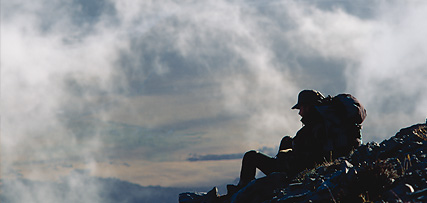Walking & Hiking
The choice in walking experiences is vast, from a gentle stroll along the coastlines of Abel Tasman National Park to a night time Kiwi-spotting expedition on Stewart Island, or being showered with spray from the world’s fifth-highest waterfall on Milford Track. Whether it’s hooking a fat trout in the Greenstone Valley, photographing alpine flora frozen in ice on the Hollyford Track or in Tongariro World Heritage Park, standing in awe at the alpine memorial for lost trampers on the Hooker Valley Track at Mount Cook, or learning first-hand about the food and medicine used by the ancient tribes of the Whirinaki rainforest, New Zealand can offer a natural or cultural experience like no other. New options are added regularly. Diversity, it’s been said, is the spice of life and New Zealand offers outdoors people plenty of that! There are great opportunities for getting back to nature within minutes of any New Zealand town or city. A huge variety of short scenic walks are accessible by road, and many are located close to cities and towns or in popular tourist areas. Some short trails even provide access for disabled visitors. With more than thirty percent of the country preserved in the National Park system – that’s more than eight million hectares – your clients will need to don a pair of hiking boots to explore the most pristine corners of New Zealand. They’ll be spoilt for choice with 12,000 kilometres of walking tracks and 1,000 huts for overnight stays. Even outside the National Parks, there are many opportunities for walking in regional parks and preserves, and along coastlines, lakes and rivers. From the top of the North to the bottom of the South Island and beyond, to several offshore islands, there are a multitude of trails ranging from fifteen-minute scenic walks to demanding multi-day hikes, ice or mountain climbs. Whatever their skill level, your clients will find the perfect way to walk New Zealand. And walking in some of the most unspoilt parts of the world is an unforgettable experience. Your clients can arrange an excursion independently, using a rental car or selecting a walk close to public transport, or they may prefer to join a guided tour and allow an expert to introduce them to New Zealand’s natural features. Many longer, multi-day walks also offer the option of going independently or with a guide. A guided walk is a good option for visitors less experienced in the outdoors and those wanting to get involved in a more intense trekking experience. Guided walks take the hassle out of organising suitable food, as well as transport to and from the track. They also offer the advantage of an experienced escort who will explain local features, history, culture and wildlife. Levels of service vary, with some operators offering transport of gear so participants won’t even have to carry a pack. If they are going independently, advise your clients to take care in their planning and seek advice before setting out. Main tracks, such as Whirinaki in the north, and Abel Tasman, Queen Charlotte, Routeburn, Milford and Hollyford in the south, are equipped with comfortable accommodation. Less well-known walks may also have basic backcountry huts for overnight stays. Visitors should always seek advice before attempting an overnight walk. It is important to be well equipped with suitable clothing, appropriate food and emergency gear, and to confirm that the chosen walk is suitable for fitness levels. Food, water and warm clothing should always be carried – the weather can change quickly in this part of the world and even short walks are less enjoyable if you’re cold and hungry! Your clients can visit a Department of Conservation Visitor and Information Centre for assistance. Whether your clients take an epic trek through mountainous terrain, or a scenic stroll through a forest or along a beach, walking in New Zealand is a wonderful way to experience the landscape close at hand.
Hiking, Arthur’s Pass – Arthur’s Pass National Park has a challenging landscape for experienced hikers Image: Tourism New Zealand, photo by Rob Suisted
New Zealand’s Great WalksThe most widely known hiking trails in New Zealand are known as the Great Walks. Administered and protected by the Department of Conservation, these trails are maintained to a high standard, with a higher standard of facilities than other trails, and can be relied upon to introduce your client to some of New Zealand’s most spectacular scenery. It is therefore no surprise that these are some of New Zealand’s most popular hikes and many require bookings. Abel Tasman Coast Track Heaphy Track Kepler Track Lake Waikaremoana Great Walk Milford Track Rakiura Track Routeburn Track Tongariro Northern Circuit Whanganui Journey |
Tips for WalkingBookings Facilities Fees Seasons
Other Renowned Hiking Tracks• Banks Peninsula Walk |

